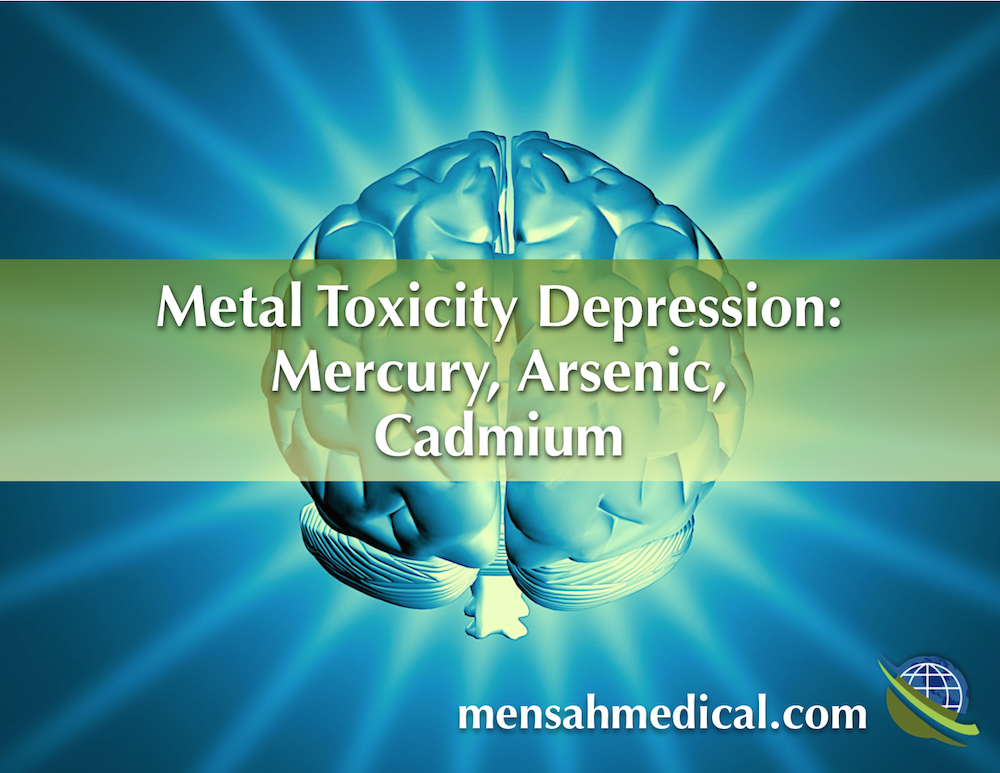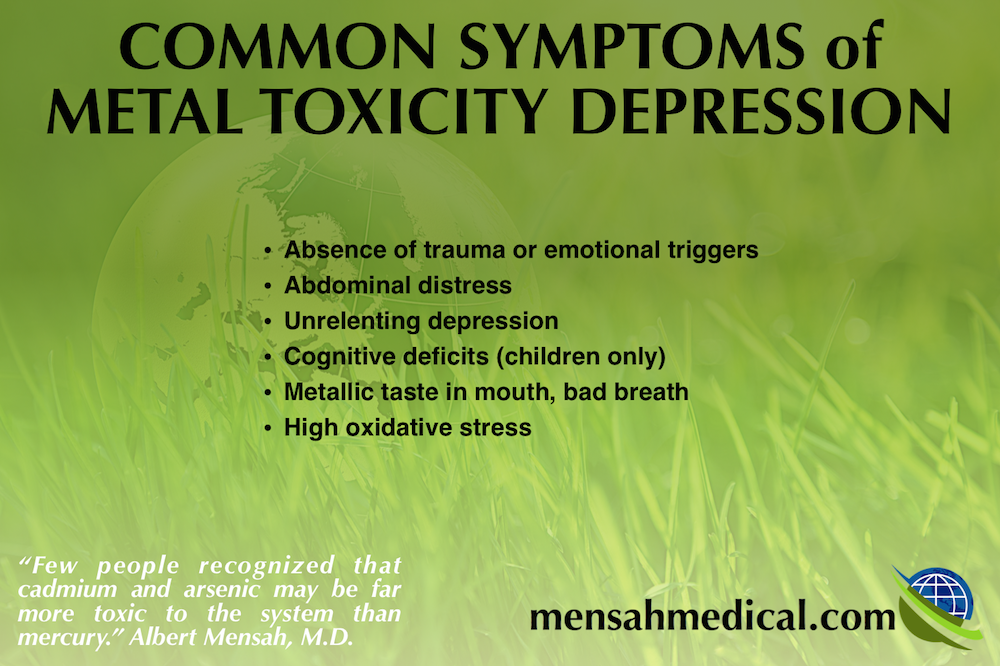Metal toxicity depression is the least common biotype for depression, not withstanding copper. In our research and in our history of empirical evidence through Carl Pfeiffer, MD, PhD, William Walsh and the Pfeiffer Treatment Center, and here at Mensah Medical we have corroborated that fewer than 5% of cases of depression are affected primarily by metal toxicity. Therefore, we rarely see cases of true metal toxicity depression. Please note, this does not include conditions of brain fog, impaired thinking, or erratic behavior.
Many people grossly generalize and self-diagnose heavy metal toxicity. Many believe that metals in the system are toxic on an ongoing level. However, the truth is that it is the ramification of metal toxicity that causes our ongoing health challenges ie: inflammation and oxidative stress. Many of those metals are biochemically inactive by the time they are discovered in lab testing. Metals have a half-life, each variable dependent on the specific metal itself. The half-life. It’s the inflammation and oxidative stress PRODUCED by those metals that leads to the challenges and difficulties we experience. In general, removing the metals without treating the resulting oxidative stress and inflammation typically does not result in resolution of symptoms with the exception of acute lead toxicity.
Often people focus on using chelation protocols, which remove the good metals in addition to the bad metals. This immediately strips the system of key and necessary components that are essential for appropriate mental health and body system regulation. Contrary to popular belief, it takes much longer to reintroduce and absorb needed nutrients into the body after chelation than removing them in the first place. As usual it only takes seconds to destroy but months to repair. Some patients often sustain immediate systemic decline and others a much more slow and gradual decline after chelation therapy. Basically, chelation therapy removes the good and the bad, thus making the patient worse in the long term. At Mensah Medical we REGULATE metals, we DO NOT chelate. We work with patients to reintroduce balance into their systems. Our protocols while regulating copper, will also bring into balance other metals like cadmium, arsenic, antimony, and other main metals.
Inflammation originally produced by heavy metals continues in an ongoing fashion until it is addressed. This is why significant antioxidant therapy helps to relieve symptoms. Examples of inflammation include foggy brain, body systemic aches and pains, joint pain, and some G.I. issues to name a few.
Mercury may not be as Dangerous as Arsenic
CHALLENGE: So much attention has been focused on mercury. However, few people recognized that cadmium and arsenic may be far more toxic to the system than mercury. Yet we commonly eat sources of these every single day. Arsenic is found in small levels in some popular foods, as well as certain plant sources.
Metal Toxicity from Lead
Lead toxicity is different. If it is an acute led toxicity diagnosis a traditional doctor will be able discover and treat. However, there is a variation involving slow lead toxicity, a gradual build up caused by impaired detoxification pathways. This is exactly how Ludwig van Beethoven died as discovered by William Walsh, PhD, lifetime founder of over seven organizations, including the Pfeiffer Treatment Center now closed. Dr. Walsh currently serves as founder and President of the Walsh Research Institute.
Common Symptoms of Metal Toxicity Depression, Excluding Copper and Lead
Onset of symptoms in metal toxicity depression are usually in the absence of an emotional trigger or trauma. In some cases the patient with metal toxicity depression will have abdominal distress. Depression is usually constant and in children there are cognitive deficits. Many patients with metal toxicity depression will have a metallic taste in the mouth.
After an average of one year, which is the average time frame for patients to complete phase 1 and phase 2 of targeted advanced nutrient therapy, 85% of our compliant patients with metal toxicity depression reported improvement and reduced medication need.
Albert Mensah, MD
 As a physician in this specialized field since 2005, Dr. Mensah, board certified in integrative pediatrics by the American Association of Integrative Medicine, has treated over 3,000 patients with advanced targeted nutrient therapy. He serves on the board at Walsh Research Institute and serves as a clinical instructor for WRI’s international doctor training programs around the world. Dr. Albert Mensah received his undergraduate degree from Northwestern University (Evanston, Illinois) and his medical degree from Finch University of Health Sciences-Chicago Medical School. Dr. Mensah’s residency was in Family Medicine at Swedish Covenant Hospital (Chicago). Following residency, he completed additional fellowship training in academic development at JHS Cook County Hospital (Chicago). From 2005 to 2008, Dr. Mensah treated patients at the former Pfeiffer Treatment Center, a not-for-profit organization and outpatient clinic specializing in the treatment of biochemical imbalances including children with autism. Prior to joining Pfeiffer, Dr. Mensah was a physician at Melrose Park Clinic in Illinois. Dr. Mensah co-founded Mensah Medical in 2008 with Dr. Judith Bowman.
As a physician in this specialized field since 2005, Dr. Mensah, board certified in integrative pediatrics by the American Association of Integrative Medicine, has treated over 3,000 patients with advanced targeted nutrient therapy. He serves on the board at Walsh Research Institute and serves as a clinical instructor for WRI’s international doctor training programs around the world. Dr. Albert Mensah received his undergraduate degree from Northwestern University (Evanston, Illinois) and his medical degree from Finch University of Health Sciences-Chicago Medical School. Dr. Mensah’s residency was in Family Medicine at Swedish Covenant Hospital (Chicago). Following residency, he completed additional fellowship training in academic development at JHS Cook County Hospital (Chicago). From 2005 to 2008, Dr. Mensah treated patients at the former Pfeiffer Treatment Center, a not-for-profit organization and outpatient clinic specializing in the treatment of biochemical imbalances including children with autism. Prior to joining Pfeiffer, Dr. Mensah was a physician at Melrose Park Clinic in Illinois. Dr. Mensah co-founded Mensah Medical in 2008 with Dr. Judith Bowman.

